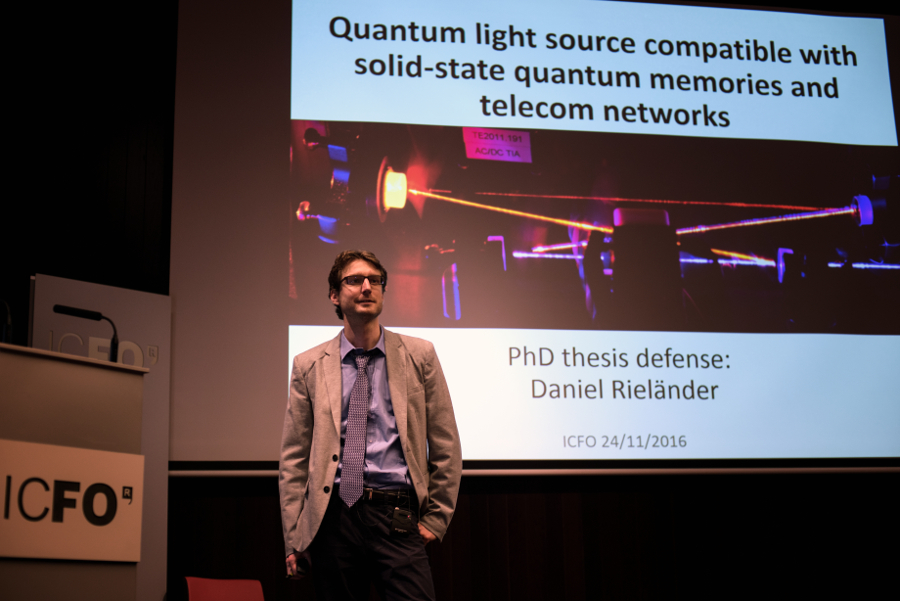24 November 2016


Dr. Daniel Rieländer has successfully defended his thesis titled “Quantum Light Source Compatible with Solid-State Quantum Memories and Telecom Networks”. Daniel is the third PhD graduate from our group. We congratulate Dr. Rieländer and wish him success in his future life!
Abstract
This PhD thesis is in the scope of experimental quantum communication. It deals with correlated photon pairs of which one photon is stored in a solid state device, while the other photon is at telecom wavelength. Quantum correlation between a photon at telecom wavelength and a photon stored in a quantum memory is an important resource for future applications like quantum repeaters, allowing the transmission quantum states over long distances.
During the first part of this thesis, a novel photon pair source has been developed, based on spontaneous parametric downconversion (SPDC) inside a bow-tie cavity. SPDC is a non-linear process which splits a pump photon sporadically into two correlated photons, called signal and idler photon. The source used in this work has been designed to be compatible with a solid state quantum memory based on a Praseodymium doped crystal, using the atomic frequency comp (AFC) protocol. This material has shown promising properties for classical light storage. However, it features a small storage bandwidth of 4 MHz at 606 nm, which sets stringent requirements for the photons to be stored. To match these requirements the SPDC process takes place inside a bowtie cavity which is resonant with the created signal and idler photons. The difference between storage wavelength and telecom wavelength (1436 nm in our case) leads to widely non-degenerate photon pairs. These double resonance leads to a strong clustering effect, which suppresses a high number of redundant spectral modes. The created photon spectrum is investigated carefully and consists of three clusters with few well separated modes. The width of each mode is around 2 MHz and matches the requirement for the quantum memory. Single mode operation was achieved by placing an additional Fabry-Perot cavity in the idler field at 1436 nm. This resulted in the demonstration of the narrowest photon pairs consisting of a spectral single mode, created by SPDC to date.
In the second part of the thesis, heralded single photons at 606 nm were created by the detection of a photon at 1436 nm. These heralded photons were then stored as collective optical excitations in a praseodymium crystal, using the AFC scheme. Non-classical correlation between the heralding photon and the stored and retrieved photons were observed for storage time up to 4 µs, 20 times longer than achieved in previous solid state quantum memory experiments.
Further development on the source, led to improved results, including an increase of coincidence count rate by one order of magnitude and a heralding efficiency of 28 %. The single photon nature of the heralded photon was also measured directly by showing strong antibunching of the 606 nm signal field. These improvements made the created photons compatible with the storage in the spin state of the praseodymium level scheme, using the full AFC protocol. That enabled an extended storage time of 11 µs with on demand readout of the stored photon.
The last part of the thesis explores another important resource for the distribution of quantum states with a quantum repeater, entanglement between the created photon pairs. Here we show a rather new approach of entanglement, which is well suited for narrow band photons based on frequency bins. We take advantage of the fact that the source naturally creates several energy correlated well separated frequency modes. In order to show the coherent superposition of the frequency modes, we use electro-optical modulators to coherently mix them. We could show high-visibility two-photon interference fringes, a strong indicator for entanglement in the frequency domain.
The results presented in this thesis open the door for the demonstration of entanglement between a solid-state spin-wave quantum memory and a photon at telecom wavelength. This represents an important step for the realization of quantum repeaters using solid state resources.
